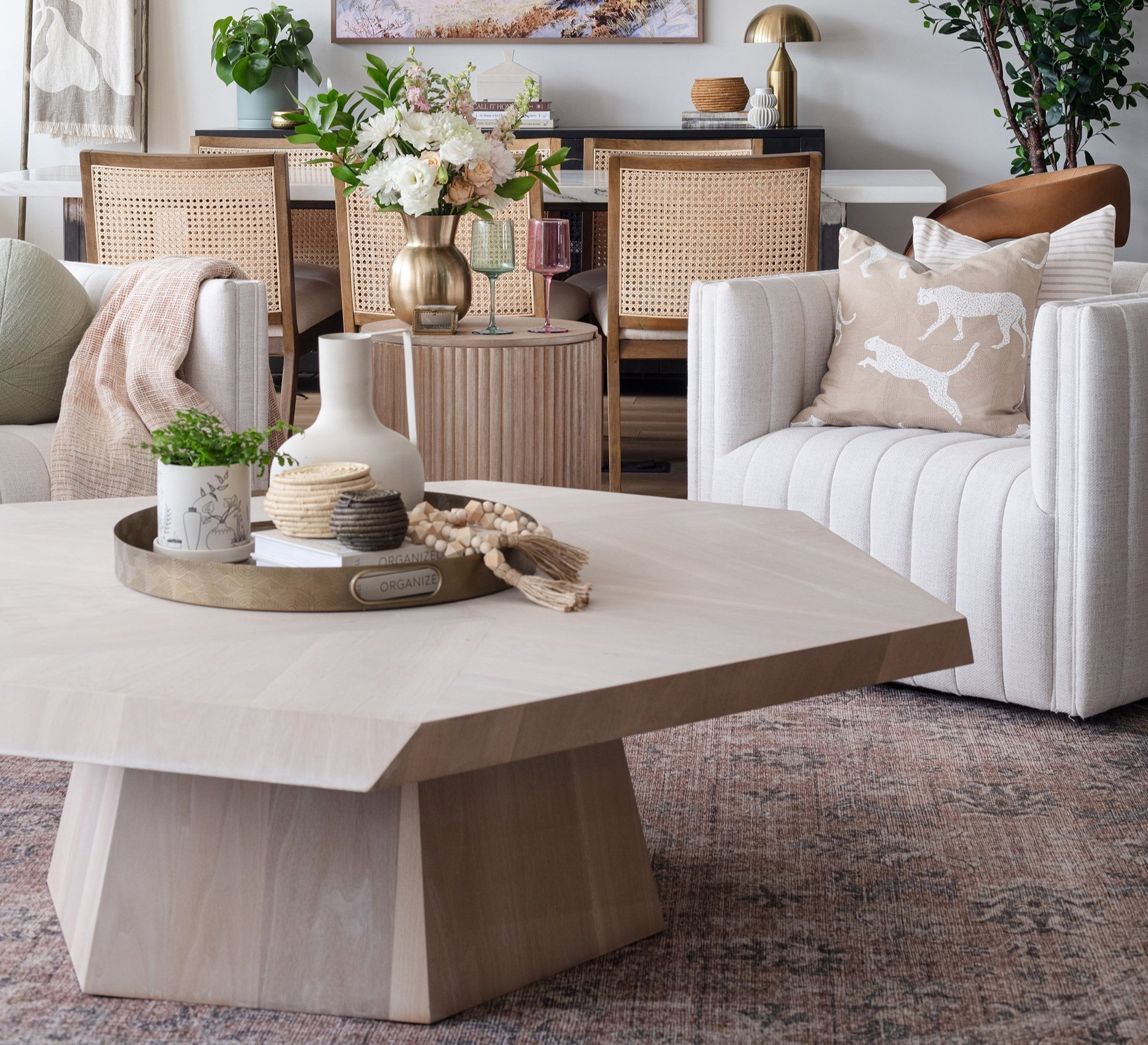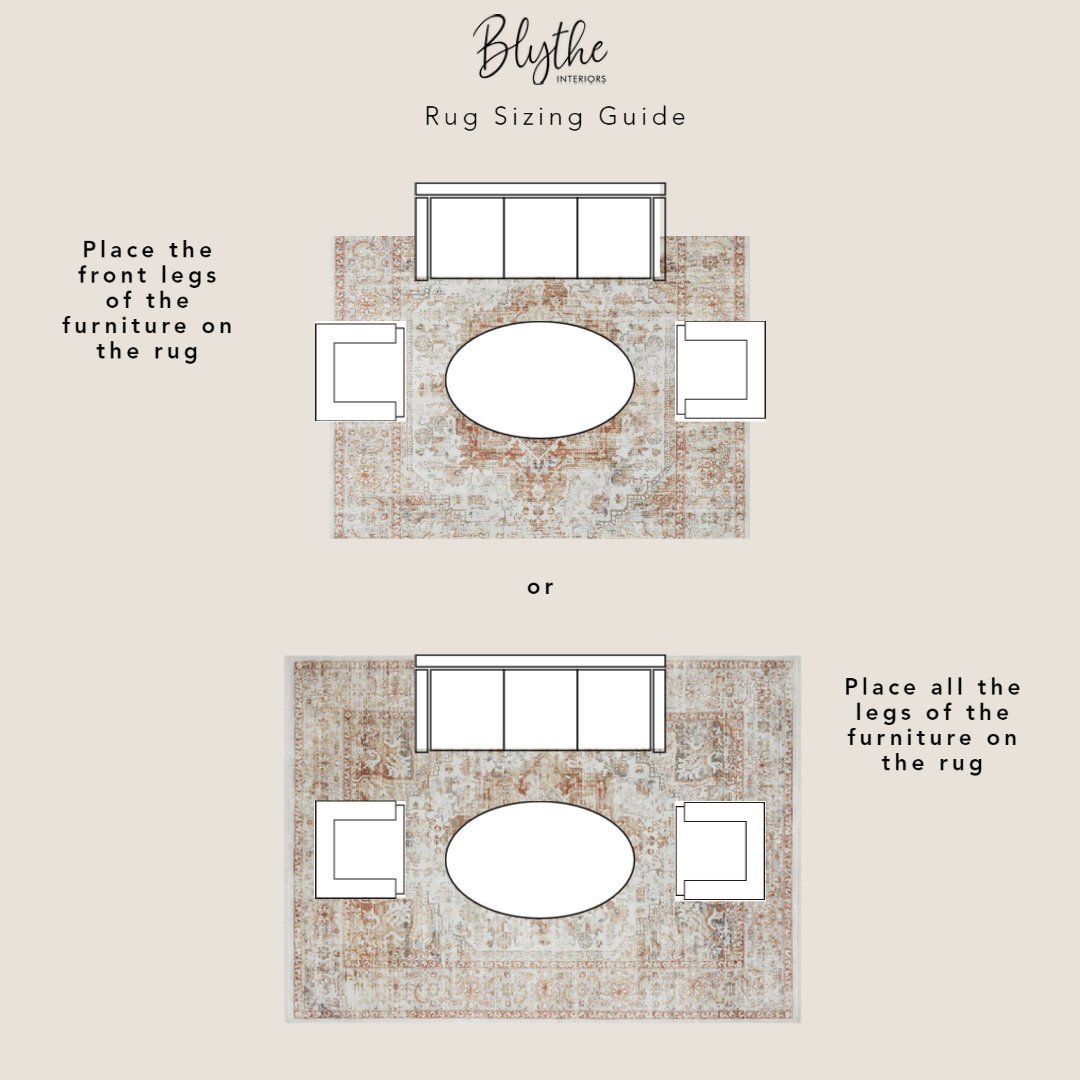HOW TO DESIGN A BEAUTIFUL AND FUNCTIONAL LIVING ROOM
While the kitchen is the heart of the home, the living room is arguably the soul. From relaxing after a long day, to hosting friends and family, the living room has many purposes and is a place where happy memories are made! So whether you’re lounging on the couch or entertaining guests, the right layout, furniture choices, and design elements can transform this central space into a true reflection of your lifestyle.
While there are probably a gazillion ways to design a living room, there are some basic elements that are needed to make your space look beautiful AND be functional - no matter your style! In this blog you’ll find tips and tricks to create the perfect layout, find the right lighting, and more!
furniture & LAYOUT
When it comes to the living room, flow is everything! This relates to the furniture and how it’s arranged so that it creates a layout that encourages conversation and a cozy atmosphere.
The size of your room will be the biggest factor when choosing your furniture but when we work with our clients, it’s important that we discover how they use their space to help figure out the type and quantity of furniture to select. For example, if someone frequently hosts parties but has a small living room, we’ll make sure to add as much extra seating as possible, while a large family might just want a big sectional with minimal additional seating to leave room for kids to run around.
LAYOUT IDEAS
No matter the direction you go, here’s a few measurements to keep in mind:
Sofa-to-Coffee Table Distance: Leave about 16-18” between the sofa and coffee table. This gives enough room to walk comfortably, while keeping the table within reach.
Traffic Flow: Leave about 36” of clearance for walkways between furniture to ensure smooth movement through the room.
Side Table Height: Side tables should be around the same height as the arm of the sofa or chairs, typically 24-27” high, to be functional and comfortable to use.
TV Height: Hang your TV level with your eyesight when sitting down. When mounting over a fireplace, consider a tilting wall mount.
LIVING ROOM FURNITURE STAPLES
Lighting
We’ve said it before and we’ll say it again, ditch that overhead lighting! Yes, you do need overhead lighting BUT by incorporating thoughtfully placed mood lighting, like lamps, you’ll create a warm and inviting ambiance that overhead lighting simply can't match. Plus, lamps can bring some serious style to your space, acting almost as a piece of art in your room.
When it comes to design and function, mood lighting allows you to highlight specific areas and create layers of light that add depth and character to a room which in turn, will give your space a beautiful, curated vibe.
RUGS & Pillows
Nothing ties together and grounds a space quite like a rug! Not only do they provide comfort and warmth, but they can act as artwork for your floor - bringing color, pattern, and life into your space. When designing a room, we love collaborating with our clients to find the perfect rug that fits their personal aesthetic and lifestyle. In addition to selecting the style, placement is incredibly important.
LIVING ROOM RUG TIPS:
Ensure that the rug is at least 8” wider than the sofa on both sides
Typically, you’ll run the rug the length of the sofa
The rug size will depend on the dimensions of the room, but most living rooms will need at least an 8’ x 10’ rug
Natural fibers like wool or cotton work wonderfully for durability and softness, while a neutral or patterned rug can either complement the room’s color palette or become a statement piece.
Match the rug shape to the room's layout. For example, use a rectangular rug in long, narrow spaces and a round rug in square or circular seating arrangements.
For pillows, first and foremost ditch the synthetic inserts! Down or down alternative pillow inserts are significantly more comfortable and allow you to get that iconic, “chopped” pillow look.
Use these tips to elevate your pillow game:
Mix Textures & Patterns: Combine different textures and prints to add depth and interest.
Vary Sizes and Shapes: Use a variety of pillow sizes and shapes to create a dynamic and layered look. Start with larger pillows at the back and work your way forward with smaller ones.
Odd Numbers Rule: Styling pillows in odd numbers—like three or five—often creates a more visually appealing and less structured arrangement.
DECOR & STYLING

The finishing touches, like decor, art and window treatments will make your space feel complete. Use these tips to create a designer-curated look!
SHELF AND COFFEE TABLE STYLING TIPS:
Trays for days - A gorgeous tray will ground your display and prevent your styling accessories from appearing scattered or disjointed.
Varying heights - By including objects of different heights, you create a sense of balance and depth. We love a tall vase for adding height!
Greenery - Try a potted plant, stems or florals! Whatever your choice, greenery adds a fresh feeling and instant mood boost that will work with any design style.
Books - Never met a coffee table book we didn’t like. They are great for adding height, color and a sophisticated vibe.
Something sculptural - Something like a decorative chain will bring an artistic feel and elevated vibe. You can also consider a fun memento from one of your travels or a personal keepsake.
Stylish storage - It might be helpful to keep things like remotes or earbuds on your coffee table, but when not in use, consider tucking them away in a decorative box to ensure they don’t cramp your style.
ART HANGING TIPS
Furniture Proportion - When hanging artwork above furniture, ensure the piece is about two-thirds to three-quarters the width of the furniture.
Eye Level Placement - The center of your artwork should generally be at eye level, which is approximately 57-60 inches from the floor.
Grouping and Gallery Walls - For a gallery wall or a grouping of multiple pieces, treat the entire collection as a single artwork. The overall width and height of the grouping should follow the same proportion rules as individual pieces relative to the wall and furniture.
Spacing Between Pieces - If you're hanging multiple pieces together, maintain consistent spacing between them. Typically, 2-3 inches of space between frames works well, but this can be adjusted based on the size of the pieces and the desired effect.
CURTAIN HANGING TIPS
Typically, you’ll want to mount the curtain rod 4”–6” inches above the window frame.
If you have high ceilings (9’ plus) you can even mount the rod at the ceiling.
The curtain rod itself should be 8” - 12” inches longer than the width of the window.
When purchasing curtains, first measure where the rod is going to be mounted, then measure from there to the floor. We always recommend adding 2” to that length to ensure your curtains aren’t too short.
STYLING FAVORITES
Thanks for reading! We hope you now feel inspired to create a beautifully designed living room. If you’re looking for specific advice about your space, contact us for an in-person or virtual consultation!
See More of Our Favorites!
This post contains affiliate links. If you use these links to buy something we may earn a commission.





































